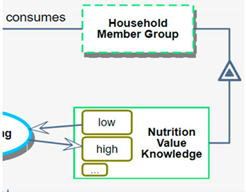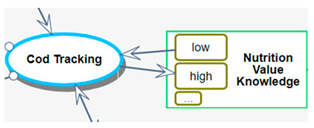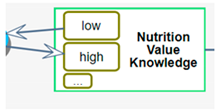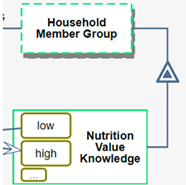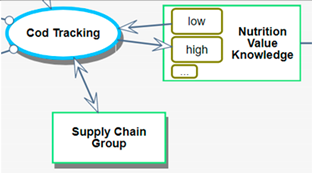Featured Application
Model-Based Systems Engineering is an edX Professional Certificate Program comprised of two five-week courses that teach principles and applications of model-based systems engineering using Object-Process Methodology—OPM ISO 19450.
Abstract
Modeling and systems thinking skills, as well as scientific understanding, are necessary for comprehending complex, food-related processes. The aim of this research was to evaluate the effect of food-related learning units on graduate students’ systems thinking and modeling skills, as well as on their understanding of science, technology, engineering, and mathematics (STEM) issues. In this research, six STEM experts constructed a conceptual model of the codfish tracking process using Object-Process Methodology. Next, 15 STEM graduate students, who are prospective teachers, participated in a graduate course, which includes four online units on food production processes based on their respective models. Research tools included an expert focus group, student assignments, and questionnaires. Modeling and scientific understanding rubrics were adapted and validated for analysis of the assignments. We found a significant difference in the scores of systems thinking and modeling skills between students with modeling background and those without. Based of students’ feedback along the course, learning in context of food and sustainability also contributed to developing these skills. The contribution is the combination of food production and conceptual models for developing STEM teachers’ systems thinking and modeling skills, and their scientific understanding of food processes and sustainability issues.
1. Introduction
In an age where problems and systems are becoming ever more interdisciplinary, system thinking is an increasingly sought-after ability. This is especially true when it comes to science, technology, engineering, and mathematics (STEM) disciplines. In response to this need, we have developed two Model-Based Systems Engineering courses as an edX Professional Certificate Program [1]. As STEM-based systems are becoming more complex, the requirement for systems thinking is increasing. Both the Next Generation Science Standards—NGSS [2] and the criteria of Accreditation Board for Engineering and Technology—ABET, 2018–2019 [3] for accrediting engineering programs include concepts related to systems thinking as part of engineering education. Developing and using models is the second of eight key practices which NGSS has recognized as the 21st-century skills [2]. The first practice is asking questions and the other six are planning and performing investigations, analyzing data, implementing computational thinking, constructing explanations, drawing arguments, and obtaining and evaluating information. According to the scientific understanding theory, background knowledge is a key to explaining phenomena [4]. The nature of science is considered a critical component of scientific literacy and has been a dominant area of research in the field of science education. Learning science has unique features, including required background knowledge, practices, methods, and methodological rules [5,6].
Citizens of the modern world are required to apply trans-disciplinary abilities that enable them to project a broad perspective and gain deep understanding of complex systems [7,8]. This makes systems thinking an increasingly important skill not only for STEM experts but also for school students, who are the citizens of tomorrow.
Beside the general trans-disciplinary knowledge and systems thinking skills, citizens should be familiar with sustainability, food production, and food nutritional values, as these subjects are critical to the future of each individual and to the planet as a whole. Therefore, learning these topics and understanding them is crucial not only for food engineers and environmental professionals but also for the community at large [9,10,11]. Consequently, increasing awareness of sustainability and food-related issues might serve as a good platform to develop systems thinking.
Project-based learning promotes meaningful learning that focuses on finding and deploying a solution to a real-life problem [12]. Learning through projects can bridge between the theory learned in class and the real world. This learning method typically integrates several disciplines and contributes to the development of various thinking skills [13,14]. Sustainability, a prominent trans-disciplinary domain of human research and activity, can promote active learners through project-based learning as they face real-life problems, and provide opportunities to incorporate project-based learning as part of the curriculum [15,16].
This work aims to facilitate communication and synergy between seemingly different domains: Food quality and food production on one hand and system thinking on the other hand. In this study, we focus on STEM teachers, who are expected to understand and address complex, interdisciplinary, real-world problems, so they can convey it effectively to their students. Such synergy is key to the teaching and learning process in STEM disciplines, and it explains the criticality of developing STEM teachers’ systems thinking and scientific understanding skills.
To achieve the goal of raising teachers’ systems thinking and scientific understanding, we have used model-based systems engineering and conceptual modeling with Object-Process Methodology—OPM [17,18,19] ISO 19450 [20] to model holistically the function, structure, and behavior of the codfish and other food production processes and value chain, ultimately enabling real-time view of the physical objects and processes along this food chain at increasing levels of detail through their digital twins. The fact that OPM is recognized as ISO 19450 is key to its international dissemination, as it can be accessed globally via the ISO online platform [20]. This specification provides a basis for understanding OPM and complying with its syntax and semantics. Table 1 presents a few abbreviations used in OPM for its two complementary, bimodal representations: the textual and the visual.

Table 1.
Abbreviations used for Object-Process Methodology—OPM representations.
1.1. Systems Thinking
Systems thinking is an approach for examining complex situations and systems in a holistic manner [8]. Systems thinking as a concept has been developed in many disciplines, including social science [21], natural sciences [22], and engineering [23]. Systems thinking in science and engineering has a dual meaning: In the context of engineering, systems thinking implies understanding of the system’s structure and behavior and the interactions between them to achieve the function, which provides value—benefit at cost—to the system’s beneficiaries [19,24]. In the context of natural sciences, systems thinking entails a description of natural phenomena, preferably through a model, which can be used to explain and analyze it both qualitatively and quantitatively, e.g., via cause-and-effect of physical, chemical, or biological events or circumstances [25]. Usually those assessments are based on attitudes or on system thinking personality traits [26,27,28]. Assessing systems thinking based on a system description, model, or representation is rare. It is important to create and use a common, unified language across disciplines for systems thinking [29]. OPM with its universal minimal ontology of objects as things that exist and processes as things that transform objects caters to systems thinking promotion. In this research, it serves as the conceptual modeling language and methodology, with models created by the experts and students serving as the basis for systems thinking assessment.
1.2. Conceptual Models and Object-Process Methodology
As the content complexity of STEM subject matter is rising, students in the various STEM disciplines are required to engage with more data, information, and knowledge. One approach to deal with this rising complexity is conceptual modeling with graphical languages and tools that support them [30].
A concept can be considered as the basic unit of knowledge [31]. Learners can use concept maps to represent their declarative knowledge structures. Concept maps comprise blocks that describe the concepts and lines linking them to informally describe relationships among the concepts by writing them along the links. Such maps can support learners in constructing new knowledge, as new information is linked to prior knowledge [32,33]. In model-based systems engineering, conceptual models are the central artifact that represents systems and provides the source of authority throughout the system lifecycle. Unlike concept maps, conceptual models use a formal graphical language, in which there may be a differentiation between several kinds of concepts or entities and several kinds of relations between the various entity kinds [19].
Figure 1 is an example of the difference between a concept map (left) and an OPM conceptual model (right). Both diagrams express the fact that a train and an aircraft are vehicles. Since concept maps are limited to concepts (graph nodes) and relations between them (graph edges), one has to specify textually the relation along each edge. In Figure 1, the two relations are “is a”. In the OPD on the right, a dedicated symbol, the blank triangle, is used to denote the “is a” relation, which in OPM is called generalization-specialization. Moreover, since OPM is bimodal, implying that each fact is modeled both graphically and textually, using the OPM modeling software OPCloud [34], OPM provides an automatic textual interpretation of the graphical representation that the modeler provides. Each symbol has a specific syntax and semantics. In this example, the blank triangle in the OPM model, which expresses the generalization-specialization relation, provides for using inheritance. Bold indicates names of objects or processes in the OPM model. Thus, if we assign to the object Vehicle the attribute Traveling Medium, this attribute is automatically inherited to its Train and Aircraft specializations, so the respective attribute values land and air can be assigned to them (not shown). The formality of conceptual models provides a more rigorous knowledge representing than that of concept maps, but proper use of a conceptual modeling language requires some learning to use it properly.
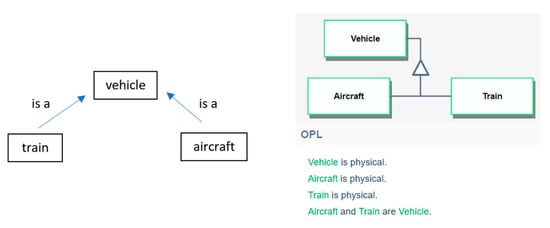
Figure 1.
An example of the difference between a concept map (left) and an OPM model (right).
Object-Process Methodology (OPM) is a formal conceptual modeling and language methodology for model-based systems engineering and conceptual modeling of systems, with a recognition by ISO 19450:2015 [20]. Each OPM element is defined as either a thing or a link. Things are objects, which can be either physical or informatical, and processes—things that happen to objects and transform them. A process transforms one or more objects by creating new objects, consuming existing objects or affect existing objects by changing their state. Objects may have states that are changed by processes. Links define structural or procedural relations between things, and each kind of link has well-defined semantics. OPM models are represented in a tree-structured hierarchy of object-process diagrams–OPDs. SD, the system diagram, is the root of the OPD tree and the highest level of abstraction. It depicts the main system’s function—a combination of a main process and one or more objects—which the process transforms. SD also includes the beneficiary—a person or a group of people—and the benefit providing attribute—the beneficiary’s attribute whose change from its input state to the output state provides the benefit that the system delivers. The top-level diagram, SD, is refined into the first detail level, SD1, which is a more detailed view of SD, elaborating on the combination of the structural, behavioral, and functional aspects of the system. The refinement can continue similarly to further levels of detail, but deeper levels beyond SD1 were not used in this research. The OPM modeling process enables systematic thinking as it is conducive to a top-down approach, in which one has to first model the beneficiary, purpose, and benefit of the system as achieved by its function, which, in turn, is a combination of a process and the operands it transforms. Figure 2 depicts an OPM model of the Chocolate Producing process. The top level, called the system diagram (SD), appears on the left of Figure 2, and the first level of detail (SD1) appears on the right, in which the process is in-zoomed. SD1 exposes its three inner subprocesses and interim object (Cocoa Beans Batch).
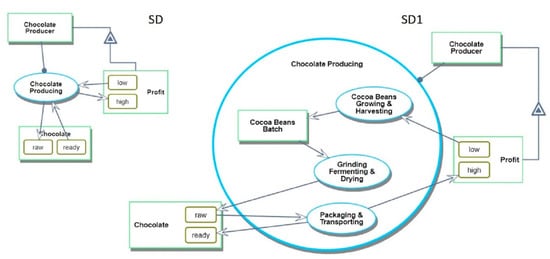
Figure 2.
Chocolate production model. SD (left) and SD1 (right).
As noted, OPM is bimodal: Any OPM model consists of two modalities, which express the same set of model facts: (1) The graphical modality–the OPD set, which is the hierarchically organized set of one or more Object Process Diagrams (OPDs) and, (2) The textual part–the OPL spec: A collection of sentences in Object Process Language (OPL)—a subset of English (or any other natural language). OPL is the counterpart textual representation of the OPD set. Each OPD construct—two or more things connected by one or more links—is reflected textually in one or more OPL sentences. This bimodal representation caters to the dual channel assumption [35,36].
1.3. Assessment of System Thinking
Science and engineering education have had distinct assessment tools for systems thinking, each emphasizing the relevant aspects and insights of its domain. The trans-disciplinary nature of modern systems and their rising complexity have been nurturing the need for a unified systems thinking assessment [26]. Sustainability and food nutritional values are topics with scientific foundations. Sustainability has global societal consequences to the future of the planet and its inhabitants, while food nutritional values impact the health of individuals and communities. Modern food production is based on agricultural and engineering principles and knowledge. The level of systems thinking for understanding of systems in these domains needs to be assessed holistically, clearly pointing to the need for a unified method and approach. Creating a common language for systems thinking across science and engineering disciplines is important [8], and it requires a high level of scientific understanding.
In the context of the natural sciences, systems thinking can be used to describe and analyze natural phenomena, events or circumstances—be they physical, chemical, biological or some combination of the three—as if they were systems [25,37,38,39]. Since OPM integrates the system’s structure, function, and behavior in one kind of diagram, and it is bimodal, it is simple enough for teaching and learning of system concepts, and for these reasons it is also suitable for assessing STEM students’ systems thinking.
1.4. Science Understanding Levels
Understanding complex, wide-scale processes requires more than acquisition of facts and memorizing terms related to these processes. Science, and specifically scientific understanding, is not exceptional in this context [40,41]. Food production and awareness of food nutritional value are issues of major concern. Learning and understanding these topics are crucial not only for food engineers and environmental professionals but for the community at large [11]. Educators should therefore teach food-related issues and systems thinking since both are of concern to society. Systems thinking, modeling, and scientific understanding skills are taught to prospective teachers and by them to their future students. These skills can strengthen the society’s control and involvement in production processes, hence contributing to sustainability. To achieve this goal, STEM teachers should be able to understand and address complex, interdisciplinary, real-world problems, such as assessing food quality and understanding complex food value chains, including their production and distribution, and their environmental effects. Equipped with knowledge and understanding of these topics, the teachers can foster their students’ systems thinking and provide them with a wide perspective of scientific topics that develop their scientific understanding.
Systems thinking in science and engineering is a dual skill: In the context of science, it entails the ability to accurately and methodically describe natural phenomena and generalize them into laws of nature. In the context of technological, engineered systems, it can be considered as holistic understanding of the system’s function, structure, and behavior, and how the latter two interact to deliver the former. With this in mind, we have combined this dual science and engineering skill in a graduate course, which was attended by graduate students from various STEM backgrounds, who are prospective teachers. The objective of this research is to evaluate the effect of educating STEM professionals, with focus on STEM educators, to apply systems thinking to food-related systems by teaching them to create and assess conceptual models with OPM.
The research questions are as follows:
(1) How can a complex food production process be modeled and evaluated?
(2) What is the effect, if any, of an OPM-based conceptual modeling of food-related systems course on graduate students’ systems thinking, modeling, and scientific understanding skills?
(3) What are the challenges and contributions that participants report during the learning processes in the course?
The rest of the paper is organized as follows. In the Material and Methods section, we introduce the EIT Food project, the research settings, population, and phases. In the Results section, findings are presented according to the research phases. The findings are discussed, and conclusions are drawn in the Discussion (Section 4) and Conclusions (Section 5).
2. Materials and Methods
This research is performed as part of an EIT Food project TRACOD—Model-Based Tracking of Cod and Other Fish Value Chain for Consumer Confidence Boosting and Food Engineers Education. EIT Food is Europe’s leading food innovation initiative, working to make the food system healthier and more trusted. The mission of EIT Food is building an inclusive and innovative community, where the consumer is actively involved [42].
To address the research questions mentioned above, the research was conducted in two phases. In Phase I, to answer the first questions, conceptual modeling experts collaborated with food professionals and modeled a food production system. Based on this model, a modeling assessment rubric was adapted and validated, as detailed in the Data Analysis section. In Phase II, relating to research questions 2 and 3, STEM students who participated in a graduate course submitted learning products. These were analyzed to determine the students’ systems thinking and modeling skills, as well as scientific understanding and their feedback on the learning process.
2.1. Research Setting—The Context of the Study and the Assignments
Global food production processes start from the region in which the raw materials, such as coffee, chocolate beans, and codfish, are collected processed, packed, and shipped worldwide. Such trans-disciplinary processes, as modeled in Phase I, are taught in the course titled Assessment of Educational Projects at the Faculty of Education in Science and technology at the Technion, Israel Institute of Technology. The course gives rise to awareness of authentic problems, which relate to sustainability, economical, engineering, and societal aspects.
2.2. Participants
The research participants in each one of the phases are presented in Table 2.

Table 2.
Research participants.
In Phase I, the six experts included two conceptual modeling experts, including one of the authors, three food professionals, and a STEM education expert who is also one of the authors. In Phase II, the participants were 15 graduate students, 11 females and four males, with diverse STEM backgrounds, who took part in the course. Three of the students had prior experience with OPM modeling while the other 12 were novice. During the course, participants were introduced to OPM while learning about food nutritional values and production systems, such as the codfish supply chain and the chocolate production process.
2.3. Research Tools
The research was conducted in two phases, with a variety of research tools to answer the three research questions. Table 3 presents the research plan, including tools and data collected.

Table 3.
Research plan.
2.3.1. Phase I
Phase I of the research included OPM modeling and food engineers focus group, in which the model of the codfish supply chain was gradually constructed. The model was created in several iterations and discussions as suggested by other engineering educators and experts [43,44]. Our model is based on input of the food engineering experts and their responses to questions asked by the modeling experts. This model is presented in the Results section.
The model was created using OPCloud [34,45]—a collaborative, cloud-based software environment for conceptual and computational modeling in OPM. The codfish ’farm to fork’ model was verified by the food professionals who were actively involved in the modeling. The iterations were necessary to build a complex model depicting several layers of understanding.
2.3.2. Phase II
In Phase II, we assessed participants’ deliverables using the three different research tools described in Table 3: (1) The course assignments were used to assess the participants’ systems thinking, (2) The participants’ final assignment included two components: Models, which were used for assessing their modeling skill, and textual with visual design, which were used for assessing their scientific understanding, and (3) feedback questionnaires, from which we gleaned participants’ perceived challenges and views on their learning process. In what follows, we describe the three tools used in Phase II.
Course Assignments
The assignments comprised of four learning units which included video clips, provided as Supplementary Materials. Two examples are: 111B-Model-Based Systems Engineering and Object-Process Methodology [46] and 311-Refinement and why we need it [47]. The difficulty level of the learning units increased incrementally to enable gradual learning of modeling concepts and to enhance scientific literacy and systems thinking. Each learning unit has three parts.
The first part of each learning unit is instructional, and includes tutorial videos, food production descriptions, specifically the chocolate making processes, and questions regarding general modeling and specific application of the production process using the learned modeling concepts. Questions at different understanding levels are included throughout the learning unit. About half of the questions are closed-ended. The open-ended questions require participant to provide explanations and construct small conceptual models of increasing systems thinking levels.
The second part includes a quiz, in which transfer of knowledge from the chocolate production process to a different food domain—the codfish supply chain—is required. The objective here is to extend students’ systems thinking and modeling skills.
The third part includes a feedback questionnaire with closed- and open-ended items regarding the participants’ perception about the learning process and their challenges and contributions.
Final Assignment
At the end of the course, each student submitted a final assignment that served for assessing scientific understanding. In this assignment, the participants were asked to design for their future students online OPM modeling assignments that are related to a specific food supply or production process of their choice, combined with one or more sustainability issues.
Feedback Questionnaire
Students’ feedback questionnaires included closed- and open-ended questions formulated to understand students’ perceptions about the challenges and contributions regarding the learning process of modeling and food production issues.
2.4. Data Analysis
In Phase I, we adapted Systems Thinking Assessment Rubric (STAR), developed by Lavi and colleagues [39] for evaluating engineering students, into STAR*, a simplified version of STAR for evaluating prospective STEM teachers. The three main system aspects evaluated in STAR are function, structure, and behavior. The function aspect describes how the beneficiaries of human-made systems benefit from the operation of those systems, while structure and behavior refer to the static and dynamic elements of any given system, respectively. STAR* is adapted to our research participants, STEM prospective teachers, whose OPM conceptual modeling knowledge level is low-to-medium. The main differences between STAR and STAR* are (1) using two slightly different criteria for two levels of OPM diagrams—the top abstract level, SD, and the first detail level, SD1, (2) omission of Attribute 8 in STAR, “Temporary objects and decision nodes”, which is beyond the modeling level of our research population, and (3) addition of examining OPL sentences (the textual modality of OPM), whose soundness and correctness provides indication of participants’ metacognitive reflection while constructing the model OPD. Table 4 presents detailed explanations for using STAR* to score the modeling skill.

Table 4.
Systems Thinking Assessment Rubric* (STAR*).
The main difference between the criterion for SD and SD1 is that for SD the attribute “Complexity level” is used (1 point for including both SD and SD1 in the model), while for SD1 “Procedural sequence”, is used, as it is relevant only for SD1, where in most cases there is a sequence of subprocesses within the main process from SD that is in-zoomed in SD1.
In Phase II, we analyzed the graduate students’ learning products. The participants’ systems thinking and the modeling levels were determined by their performance in the four learning unit assignments, which were validated by the STEM education experts.
The final assignment was analyzed by two different rubrics: The OPM model in the final assignment was assessed using STAR*, while the Scientific Understanding Rubric (SUR), presented in Table 5, was used to assess the scientific understanding. The modeling skill was evaluated using STAR*. The scores rated by the three experts based on STAR* received 84% interrater reliability [48,49].

Table 5.
The Scientific Understanding Rubric (SUR).
To evaluate the participants’ scientific understanding, we analyzed the mini-projects participants composed using the SUR, which consists of three categories (see Table 5): (C1) digital and visual design, (C2) context related to food processing and sustainability issues [50,51,52], and (C3) a variety of activities. Each SUR criterion can score up to 2 or 4 points, yielding a maximum score of 10.
The SUR rubric received 90% interrater reliability [48,49] between three experts. To understand students’ challenges and contributions in relations to systems thinking, modeling, and food processes, we analyzed their feedbacks, which included students’ ranking (1–5) of the learning units’ aspects in a Likert scale and identified themes in the open-ended questions [53].
2.5. Ethics
All subjects gave their informed consent for inclusion prior to their participation in the study. This research is part of the EIT Food project TRACOD, titled Model-Based Tracking of Cod and Other Fish Value Chain for Consumer Confidence Boosting and Food Engineers Education. This project was reviewed and approved by the Behavioral Sciences Research Ethics Committee of the Technion—Israel Institute of Technology. Approval number 2020–165 was received on 16 July 2020.
3. Results
We present the results according to the research phases.
3.1. Phase I—Case Study: Experts’ Modeling of Food Production Processes
Phase I, related to the first research question, resulted in a detailed model of the codfish supply chain. At the point of sale, fresh fish can be measured by the vendor or even the consumer, with immediate response presented and printed on a sticky label that accompanies the fish fillet all the way to the consumer’s kitchen. In this project, we used fish articles as food examples, of which relevant data including food quality and authenticity (FQA; e.g., species, nutritional value, freshness level) along the supply chain is exposed. We empower the consumer to ensure that the specific fish she or he is buying is authentic, what its various nutritional values are, and additional details of interest, such as the place and time of catch and possibly even details of the fishing vessel and captain. The comparison of the freshness value at the point of sale to that at the point of packaging will inform the customer about the level of degradation in quality, which should be minimized and can be a new factor in determining the price of the fish, in addition to the species and the weight. Following are the diagrams presenting the model. Figure 3 presents the SD level—model and OPL.
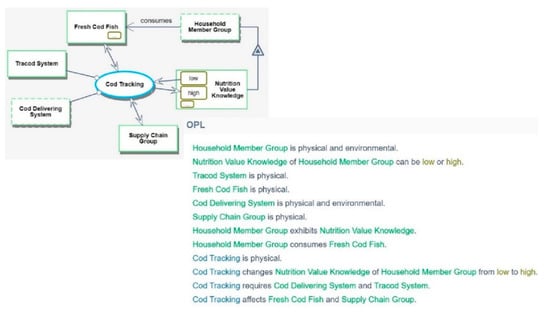
Figure 3.
System diagram (SD) of codfish supply chain OPM model prepared by food and modeling experts.
The main process in the model in Figure 3 is Cod Tracking, which changes the Nutrition Value Knowledge of the Household Member Group from low to high. This is the benefit of the Cod Tracking process. Links in OPM are of several kinds. For example, in Figure 3, the double arrowhead link between the process Cod Tracking and the object Supply Chain Group is an effect link, implying that the process affects the object. The “white lollipop” between TRACOD System and Cod Tracking is an instrument link, implying that TRACOD System is required for Cod Tracking. These facts are also expressed textually in the same figure.
This model was analyzed according to STAR*. Table 6 presents the scoring of the SD level according to this rubric.

Table 6.
STAR* analysis of codfish supply chain model—SD level.
Figure 4 presents SD1 level of the codfish supply chain model. This is the first detail level of the model in Figure 3. It presents the sub-processes of the Cod Tracking process and the objects that are involved in this process.
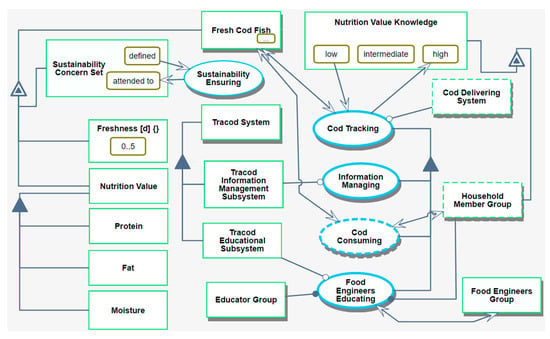
Figure 4.
SD1—The first detail level of the codfish supply chain OPM model whose SD is in Figure 3.
The OPL and analysis of the model in Figure 4 (based on the STAR* for assessing SD1) appear in Appendix A. The modeling stage and focus group interactions raised questions with which the food professionals have never dealt with before, which caused rethinking the process and improving it. The process of creating the models enables each food professional group member to express the functions and roles of the different parts within the process.
3.2. Phase II—Assessing Students Systems Thinking, Modeling and Scientific Understanding
Phase II, which is related to research questions 2 and 3, included three steps: (1) Assessing students’ systems thinking, modeling and scientific understanding, and statistical analysis; (2) detailed analysis of several examples; and (3) feedback analysis.
We classified the participants according to their systems thinking, modeling, and scientific understanding levels. Participants whose systems thinking and modeling levels were at least 8 were classified as high while others were classified as low. Similarly, participants whose scientific understanding level scored at least 8 were classified as high while others were classified as low. Figure 5 presents the distribution of students according to their systems thinking and modeling skill levels and their scientific understanding level in four groups.
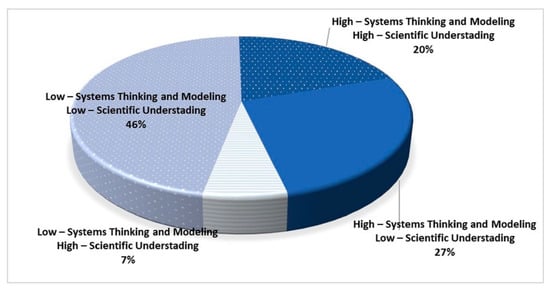
Figure 5.
Distribution of students’ skills levels (N = 15).
In order to test the differences between students with prior experience in OPM modeling and novice students, we ran a Man–Whitney test. The experienced students had higher modeling (Median = 9) and higher systems thinking (Median = 9) skills than the novice students’ modeling (Median = 5.5) and systems thinking (Median = 6) skills. The Mann–Whitney test indicated that these differences were statistically significant. For modeling: U(experience = 3, novice = 12) = 5, z = −1.959, p = 0.05. For systems thinking, U(experience = 3, novice = 12) = 3.5, z = −2.11, p < 0.05. No significant correlations were found between the levels of systems thinking and modeling skills and scientific understanding.
Following are in-depth analysis examples of two participants. The first example, presented in Figure 6, is of a participant who is experienced in using OPCloud for OPM-based modeling, while the second is of a novice modeling participant.
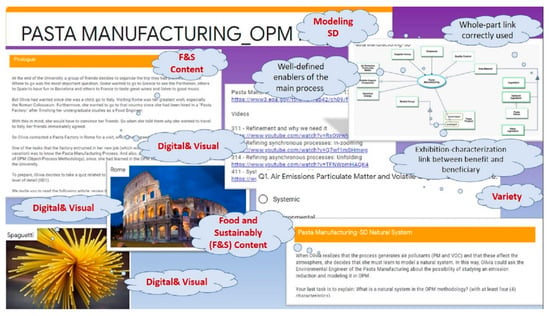
Figure 6.
Selected segments of the final assignment submitted by participant #722122205.
The modeling score of this participant was calculated based on STAR* (Table 4). The explanations for the detailed scoring are presented in Table 7 below. The model itself appear in Figure 6, and appears in full scale in Appendix B.

Table 7.
Explanation of participant #722122205 modeling score.
The scientific understanding score was calculated based on the rubric presented in the Materials and Methods section, Table 5.
The experienced student’s assignment presented in Figure 6 was evaluated based on the following evaluation:
- Digital and Visual Design (4/4)—The assignment contains designed interface including colors, models, image, and video clips.
- Food processing and sustainability context (4/4)—The questions combine several issues of food processes and sustainability.
- Variety (1/2)—There is a variety of activities but no special assignment.
In summary, the total score is 9/10.
The second example, presented in Figure 7, is of a student who is novice in modeling.
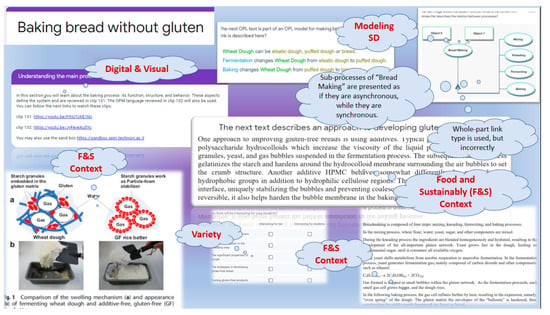
Figure 7.
Selected segments of the final assignment submitted by participant # 112122201.
The modeling score of this participant was calculated based on the rubric presented in Section 2, Table 4. Detailed explanation for the modeling score is presented in Table 8 below. The model itself appear in Figure 7.

Table 8.
Explanation of participant # 112122201 modeling score.
The scientific understanding score was calculated based on the rubric presented in Section 2, Table 5. According to Figure 7 the evaluation of this assignment is based on the following reasoning:
- Digital and Visual Design (4/4)—contains designed interface including colors, models, image, and video clips
- Food processing and sustainability context (4/4)—the questions include assimilation of a few issues of both food processes and sustainability. In addition, the assignment integrates multiple complex scientific analysis of the chemical processes
- Variety (2/2)—a variety of activities and a special assignment that did not appear in previous exercises
In summary, the total score is 10/10.
We analyzed the participants’ feedback evaluate the challenges and benefits students faced during their learning process. In the open-ended questions, participants raised several issues, including cognitive, technical, and social issues, as well as challenges with the systems thinking and modeling aspects. For example, one student stated: “In the practical aspect of replying to the codfish assignment, I had trouble building a model that will include the components in a meaningful way.” [222122201]. Another student stated: “The first difficulty was thinking about asynchronous processes in the food production.” [72212205].
Students’ reflections on the final assignment raised additional aspects, including the following.
- The need for iterations to clarify issues: “We had an iterative discussion until we found the optimal solution for the evaluation tool” [212122201].
- Acquiring a broad viewpoint: “The process made me think in a broader, systematic viewpoint and to relate to the links between the different components” [112122201].
- Applying reverse engineering: “The challenge in creating an OPM model made me use reverse engineering to articulate the assignment” [412122201].
Figure 8 presents analysis of the students’ feedback regarding contributions of the course to the understanding of modeling and systems thinking as well as understanding of food processes, by the learning units, based on their Likert scale statements. The graphs show that students’ perceptions of the contribution of the course to their systems thinking and modeling is consistently higher than to understanding food processes, with both showing a similar trend.
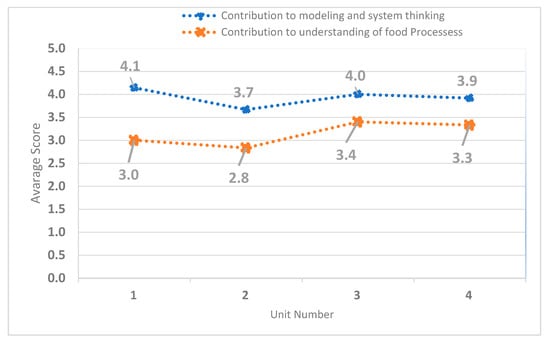
Figure 8.
Students’ feedbacks regarding systems thinking, modeling, and understanding of food processes.
4. Discussion
Guaranteeing food quality and authenticity is a challenging task with common interest for all students, as they are also consumers of food, making this topic suitable for context-based learning. At these times, while the COVID19 pandemic exerts impact on production and transportation of food worldwide, citizen understanding of food production process is of particular importance.
The first research question was: How can a complex food production process be modeled and evaluated? Modeling these processes requires system thinking which is developed while learning conceptual modeling with Object Process Methodology (OPM) using OPCloud. A trans-disciplinary team is needed to build such a model. Once built, the model can serve as part of learning materials for modeling context-based narratives focusing on environmental and food-related issues [7,44,52].
The second research question was: What is the effect, if any, of an OPM-based conceptual modeling of food-related systems course on graduate students’ systems thinking, modeling, and scientific understanding skills? We found a significant difference between students with modeling experience and those who were novices. As found before, gradual long-term processes are needed in order to develop these skills [26,27]. This indicates that practicing the modeling skill might improve systems thinking. More research is needed to determine the long-term effect of the link between modeling and systems thinking skills. We recommend using these skills in studies of complex processes and sustainability issues, in line with some of the NGSS recommendations [2].
The third research question was: What are the challenges and contributions that participants report during the learning processes? The students’ feedback indicated that understanding food processes and modeling have similar trends. These similarities provides an indication that food and sustainability can be effectively used to develop systems thinking and modeling skills as they enable learning in context which contributes to the learning process [50,51,52].
Overall, we found that the course contributed to the students, who are prospective teachers, in both the systems thinking and modeling skill perspectives, as well as to their scientific understanding and awareness to nutritional values and sustainability issues.
5. Conclusions
In this research we evaluated the effect of four food-related learning units, which were based on a part of an online model-based systems engineering course with OPM [1], on graduate students’ systems thinking and modeling skills, as well as on their understanding of STEM.
A limitation of the study is the small number of participants. Future research should include a larger sample. We suggest replicating this study with larger groups and continue validating the two rubrics used in this research.
This research has methodological, practical, and theoretical contributions. The methodological contributions are the two rubrics we adapted. The first, STAR*, enables assessing the modeling skill of prospective teachers who have low-to-medium modeling and system thinking skills in many cases. The second, SUR, enables assessing teachers’ scientific understating based on their self-designed online assignments. The practical contributions and findings application include the development of four learning units with questions at various difficulty levels, which exposes teachers and students to conceptual modeling using the OPCloud modeling tool. The learning materials and rubrics can assist STEM students and professionals in developing their systems thinking and modeling skills, as well as their scientific understanding. The theoretical contribution of this study is the innovative combination of food production processes and OPM-based conceptual modeling for developing STEM teachers’ system thinking skill, their modeling skill, and their scientific understanding of food processes and sustainability issues.
Supplementary Materials
The following are available online at https://www.mdpi.com/2076-3417/10/21/7417/s1, Table S1: Video Clips List by Learning Units.
Author Contributions
Conceptualization, D.D. and Y.J.D.; methodology, E.A., M.T., D.D. and Y.J.D.; software, D.D.; validation, M.T., R.P., D.D. and Y.J.D.; formal analysis, E.A., M.T. and R.P.; investigation, E.A. and M.T.; resources, D.D. and Y.J.D.; data curation, E.A., M.T. and Y.J.D.; writing—original draft preparation, E.A. and M.T.; writing—review and editing, E.A., M.T., R.P., D.D. and Y.J.D.; visualization, E.A.; supervision, D.D. and Y.J.D.; project administration, E.A., D.D. and Y.J.D.; funding acquisition, D.D. and Y.J.D. All authors have read and agreed to the published version of the manuscript.
Funding
This research was funded partially by (1) the EIT Food 2020 Project #20124—TRACOD—Model-based Tracking of Cod and Other Fish Value Chain for Consumer Confidence Boosting and Food Engineers Education, and (2) the Bernard M. Gordon Center for System Engineering, Technion, Grant 2028379.
Acknowledgments
We would like to thank Rea Lavi from Massachusetts Institute of Technology for his insightful comments on the manuscript, Guðjón Þorkelsson and Guðmundur Stefánsson from Matis and University of Island for taking part in the modeling, and (3) the graduate students from the Technion, who participated in the course.
Conflicts of Interest
The authors declare no conflict of interest.
Appendix A. OPL and Modeling Rubric for Assessing SD1 of the Codfish Supply Chain Process
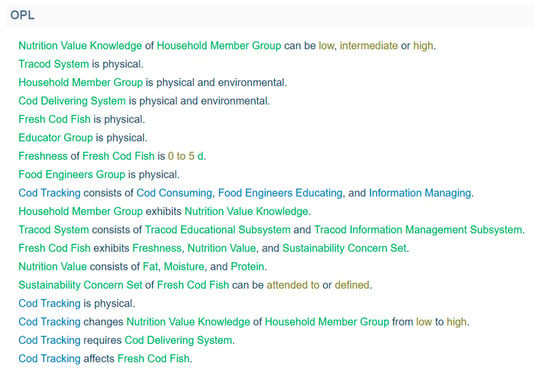
Figure A1.
OPL for SD1 of codfish supply chain drawn by the expert.

Table A1.
Rubric assessing SD1 model of codfish supply chain.
Table A1.
Rubric assessing SD1 model of codfish supply chain.
| Attribute | Scoring | Examples in the Model |
|---|---|---|
| A1-Intended Purpose | Two points. The beneficiary, Household Member Group, exhibits the benefit, Nutrition Value Knowledge at state high. | 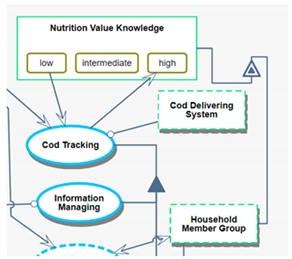 |
| A2-Main Function | Two points. Three sub-processes in addition to the main process. The main process (Cod Tracking) transforms (in this case- changes) Nutrition Value Knowledge from low to high. |  |
| A3-Main Object | One point. Main object: Nutrition Value Knowledge, plus many other new objects directly linked with sub-processes or with the main process. | 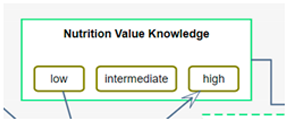 |
| A4-Structural relations | One point. Two different links: exhibition-characterization link and whole-part link. | 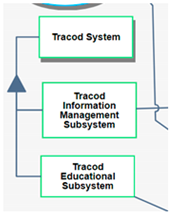 |
| A5-Procedural relations | One point. Two different links: Effect link and output-input link-pair. | 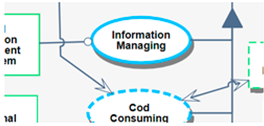 |
| A6-Procedural Sequence | One point. Procedural sequence is coherent and detailed. | |
| A9-OPL main process functional sentences | One point. |   |
| A10-OPL main process procedural sentences | One point. |   |
| Total Scoring: 10/10 points |
Appendix B. OPM Model Submitted by Participant #722122205
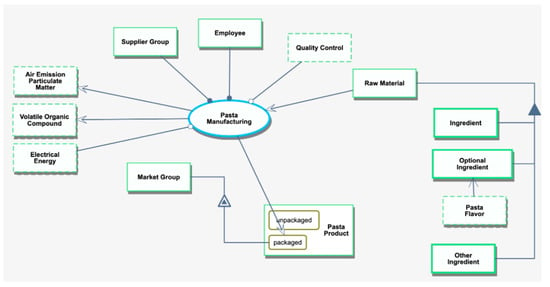
Figure A2.
Model presented as part of the assignment submitted by participant #722122205.
References
- Dori, D. Model-Based Systems Engineering—MBSE. Available online: https://www.edx.org/professional-certificate/israelx-model-based-systems-engineering (accessed on 4 October 2020).
- NGSS Lead States. Next Generation Science Standards: For States, By States. In Next Generation Science Standards: For States, By States; National Academies Press: Washington, DC, USA, 2013; pp. 1–504. [Google Scholar] [CrossRef]
- Accreditation Board for Engineering and Technology. Computing Accreditation Commission Criteria for Accrediting Computing Programs 2019–2020; ABET Publishing: Baltimore, MD, USA, 2019. [Google Scholar]
- Schurz, G.; Lambert, K. Outline of a Theory of Scientific Understanding. Synthese 1994, 101, 65–120. [Google Scholar]
- Dagher, Z.R.; Erduran, S. Reconceptualizing the Nature of Science for Science Education: Why Does It Matter? Sci. Educ. 2016, 25, 147–164. [Google Scholar] [CrossRef]
- Schleicher, A. PISA 2018: Insights and Interpretations; OECD Publishing: Paris, France, 2019. [Google Scholar]
- Sauvé, S.; Bernard, S.; Sloan, P. Environmental Sciences, Sustainable Development and Circular Economy: Alternative Concepts for Trans-Disciplinary Research. Environ. Dev. 2016, 17, 48–56. [Google Scholar] [CrossRef]
- York, S.; Lavi, R.; Dori, Y.J.; Orgill, M.K. Applications of Systems Thinking in STEM Education. J. Chem. Educ. 2019, 96, 2742–2751. [Google Scholar] [CrossRef]
- Lavi, R.; Dori, Y.J.; Dori, D. Assessing Novelty and Systems Thinking in Conceptual Models of Technological Systems. IEEE Trans. Educ. 2020, 1–8. [Google Scholar] [CrossRef]
- Shvetsova, O.A.; Lee, J.H. Minimizing the Environmental Impact of Industrial Production: Evidence from South Korean Waste Treatment Investment Projects. Appl. Sci. 2020, 10, 3489. [Google Scholar] [CrossRef]
- Viljoen, A.; Wiskerke, J.S.C. Sustainable Food Planning: Evolving Theory and Practice; Wageningen Academic Publishers: Wageningen, The Netherlands, 2012. [Google Scholar]
- Blumenfeld, P.C.; Soloway, E.; Marx, R.W.; Krajcik, J.S.; Guzdial, M.; Palincsar, A. Motivating Project-Based Learning: Sustaining the Doing, Supporting the Learning. Educ. Psychol. 1991, 369–398. [Google Scholar] [CrossRef]
- Bilgin, I.; Karakuyu, Y.; Ay, Y. The Effects of Project Based Learning on Undergraduate Students’ Achievement and Self-Efficacy Beliefs towards Science Teaching. Eurasia J. Math. Sci. Technol. Educ. 2015, 11, 469–477. [Google Scholar] [CrossRef]
- Crismond, D.P. Scaffolding Strategies For Integrating Engineering Design and Scientific Inquiry in Project-Based Learning Environments. In Fostering Human Development Through Engineering and Technology Education; Brill Sense: Leiden, The Netherlands, 2011. [Google Scholar] [CrossRef]
- Taheri, P. Project-Based Approach in a First-Year Engineering Course to Promote Project Management and Sustainability. Int. J. Eng. Pedagog. 2018, 8, 104–119. [Google Scholar] [CrossRef]
- Wiek, A.; Xiong, A.; Brundiers, K.; van der Leeuw, S. Integrating Problem and Project-Based Learning into Sustainability Programs: A Case Study on the School of Sustainability at Arizona State University. Int. J. Sustain. High. Educ. 2014, 15, 431–449. [Google Scholar] [CrossRef]
- Dori, D. Object-Process Analysis: Maintaining the Balance between System Structure and Behaviour. J. Log. Comput. 1995, 5, 227–249. [Google Scholar] [CrossRef]
- Dori, D. Object-Process Methodology: A Holistic Systems Paradigm; Springer: New York, NY, USA, 2002; pp. 1–12. [Google Scholar]
- Dori, D. Model-Based Systems Engineering with OPM and SysML; Springer: New York, NY, USA, 2016. [Google Scholar] [CrossRef]
- ISO. ISO/PAS 19450: 2015—Automation Systems and Integration—Object-Process Methodology; ISO: Geneva, Switzerland, 2015; Available online: https://www.iso.org/obp/ui/#iso:std:iso:pas:19450:ed-1:v1:en (accessed on 4 October 2020).
- Senge, P.M. The Fifth Discipline, the Art and Practice of the Learning Organization. In Performance + Instruction; Doubleday: New York, NY, USA, 1991; p. 37. [Google Scholar] [CrossRef]
- Von Bertalanffy, L. The Theory of Open Systems in Physics and Biology. Science 1950, 111, 23–29. [Google Scholar] [CrossRef]
- Dym, C.L.; Agogino, A.M.; Eris, O.; Frey, D.D.; Leifer, L.J. Engineering Design Thinking, Teaching, and Learning. IEEE Eng. Manag. Rev. 2006, 34, 65–90. [Google Scholar] [CrossRef]
- Crawley, E.; Cameron, B.; Selva, D. Systems Architecture: Strategy and Product Development for Complex Systems; Pearson Education: London, UK, 2015. [Google Scholar]
- Checkland, P. Soft Systems Methodology: A Thirty Year Retrospective. Syst. Res. Behav. Sci. 2000, 17, S11–S58. [Google Scholar] [CrossRef]
- Gero, A.; Zach, E. High School Programme in Electro-Optics: A Case Study on Interdisciplinary Learning and Systems Thinking. Int. J. Eng. Educ. 2014, 30, 1190–1199. [Google Scholar]
- Frank, M. Knowledge, Abilities, Cognitive Characteristics and Behavioral Competences of Engineers with High Capacity for Engineering Systems Thinking (CEST). Syst. Eng. 2006, 9, 91–103. [Google Scholar] [CrossRef]
- Camelia, F.; Ferris, T.L.J.; Cropley, D.H. Development and Initial Validation of an Instrument to Measure Students’ Learning about Systems Thinking: The Affective Domain. IEEE Syst. J. 2018, 12, 115–124. [Google Scholar] [CrossRef]
- Whitehead, N.P.; Scherer, W.T.; Smith, M.C. Systems Thinking about Systems Thinking: A Proposal for a Common Language. IEEE Syst. J. 2015, 9, 1117–1128. [Google Scholar] [CrossRef]
- Aubrecht, K.B.; Dori, Y.J.; Holme, T.A.; Lavi, R.; Matlin, S.A.; Orgill, M.; Skaza-Acosta, H. Graphical Tools for Conceptualizing Systems Thinking in Chemistry Education. J. Chem. Educ. 2019, 96, 2888–2900. [Google Scholar] [CrossRef]
- Duit, R.; Treagust, D.F. Conceptual Change: A Powerful Framework for Improving Science Teaching and Learning. Int. J. Sci. Educ. 2003, 25, 671–688. [Google Scholar] [CrossRef]
- Novak, J.D.; Gowin, D.B. Learning How to Learn; Cambridge University Press: Cambridge, UK, 1984. [Google Scholar]
- Ruiz-Primo, M.A.; Shavelson, R.J. Problems and Issues in the Use of Concept Maps in Science Assessment. J. Res. Sci. Teach. 1996, 33, 569–600. [Google Scholar] [CrossRef]
- Dori, D.; Kohen, H.; Jbara, A.; Wengrowicz, N.; Lavi, R.; Soskin, N.L.; Bernstein, K.; Shani, U. OPCloud: An OPM Integrated Conceptual-Executable Modeling Environment for Industry 4.0. Syst. Eng. Fourth Ind. Revolut. 2019, 243–271. [Google Scholar] [CrossRef]
- Mayer, R.E. The Promise of Multimedia Learning: Using the Same Instructional Design Methods across Different Media. Learn. Instr. 2003, 13, 125–139. [Google Scholar] [CrossRef]
- Mayer, R.E.; Moreno, R. Nine Ways to Reduce Cognitive Load in Multimedia Learning. Educ. Psychol. 2003, 38, 43–52. [Google Scholar] [CrossRef]
- Assaraf, O.B.Z.; Orion, N. Development of System Thinking Skills in the Context of Earth System Education. J. Res. Sci. Teach. 2005, 42, 518–560. [Google Scholar] [CrossRef]
- Lavi, R.; Dori, Y.J. Systems Thinking of Pre- and in-Service Science and Engineering Teachers. Int. J. Sci. Educ. 2019, 41, 248–279. [Google Scholar] [CrossRef]
- Lavi, R.; Dori, Y.J.; Wengrowicz, N.; Dori, D. Model-Based Systems Thinking: Assessing Engineering Student Teams. IEEE Trans. Educ. 2020, 63, 39–47. [Google Scholar] [CrossRef]
- Dellsén, F. Scientific Progress: Knowledge versus Understanding. Stud. Hist. Philos. Sci. Part A 2016, 56, 72–83. [Google Scholar] [CrossRef]
- Kosso, P. Scientific Understanding. Found. Sci. 2007, 12, 173–188. [Google Scholar] [CrossRef]
- European Institution of Innovation and Technology EIT. EIT Food. Available online: https://eit.europa.eu/eit-community/eit-food (accessed on 4 October 2020).
- Wärmefjord, K.; Söderberg, R.; Schleich, B.; Wang, H. Digital Twin for Variation Management: A General Framework and Identification of Industrial Challenges Related to the Implementation. Appl. Sci. 2020, 10, 3342. [Google Scholar] [CrossRef]
- Martinec, T.; Škec, S.; Perišić, M.M.; Štorga, M. Revisiting Problem-Solution Co-Evolution in the Context of Team Conceptual Design Activity. Appl. Sci. 2020, 10, 6303. [Google Scholar] [CrossRef]
- Dori, D.; Jbara, A.; Levi, N.; Wengrowicz, N. Object-Process Methodology, OPM ISO 19450 – OPCloud and the Evolution of OPM Modeling Tools. Syst. Eng. Newsl. PPI SyEN 2018, 61, 6–17. [Google Scholar]
- Dori, D. 111B—Model-Based Systems Engineering and Object-Process Methodology. Available online: https://www.youtube.com/watch?v=5767ZTx9IcM&list=PL7H3hAs1csPj5Gt2PHJT_HqQQo6IzzSjn&index=3 (accessed on 16 October 2020).
- Dori, D. 311—Refinement and Why We Need It. Available online: https://www.youtube.com/watch?v=yyadn_pleHg&list=PL7H3hAs1csPj5Gt2PHJT_HqQQo6IzzSjn&index=19 (accessed on 16 October 2020).
- Belur, J.; Tompson, L.; Thornton, A.; Simon, M. Interrater Reliability in Systematic Review Methodology: Exploring Variation in Coder Decision-Making. Sociol. Methods Res. 2018. [Google Scholar] [CrossRef]
- Kottner, J.; Audige, L.; Brorson, S.; Donner, A.; Gajewski, B.J.; Hróbjartsson, A.; Roberts, C.; Shoukri, M.; Streiner, D.L. Guidelines for Reporting Reliability and Agreement Studies (GRRAS) Were Proposed. Int. J. Nurs. Stud. 2011, 48, 661–671. [Google Scholar] [CrossRef]
- Sevian, H.; Dori, Y.J.; Parchmann, I. How Does STEM Context-Based Learning Work: What We Know and What We Still Do Not Know. Int. J. Sci. Educ. 2018, 40, 1095–1107. [Google Scholar] [CrossRef]
- Pabuccu, A.; Erduran, S. Investigating Students’ Engagement in Epistemic and Narrative Practices of Chemistry in the Context of a Story on Gas Behavior. Chem. Educ. Res. Pract. 2016, 17, 523–531. [Google Scholar] [CrossRef]
- Hofstein, A.; Eilks, I.; Bybee, R. Societal Issues and Their Importance for Contemporary Science Education-a Pedagogical Justification and the State-of-the-Art in Israel, Germany, and the USA. Int. J. Sci. Math. Educ. 2011, 9, 1459–1483. [Google Scholar] [CrossRef]
- Gibson, A.; Kitto, K.; Bruza, P. Towards the Discovery of Learner Metacognition From Reflective Writing. J. Learn. Anal. 2016, 3, 22–36. [Google Scholar] [CrossRef]
Publisher’s Note: MDPI stays neutral with regard to jurisdictional claims in published maps and institutional affiliations. |
© 2020 by the authors. Licensee MDPI, Basel, Switzerland. This article is an open access article distributed under the terms and conditions of the Creative Commons Attribution (CC BY) license (http://creativecommons.org/licenses/by/4.0/).
